A French Indian Ocean Service
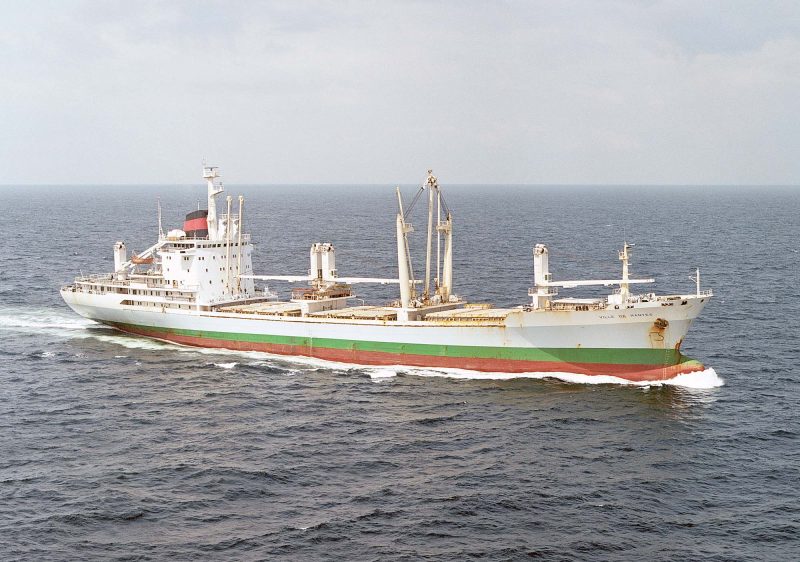
The island of Reunion was claimed by France in 1638 and settled in 1665 under the name of Bourbon Island, gaining the name of Reunion in 1793, and it has remained as French territory until the present day except for a short period during the Napoleonic Wars. The island lies 500 miles east of Madagascar and is 969 square miles in area with one active volcano and nine dormant volcanoes. There are coastal plains suitable for growing sugar cane, vanilla, tea, maize, potatoes, tapioca and aromatic spices and herbs. The vast majority of the land (over 70%) is devoted to sugar cane, and the distillation of sugar residues or molasses into rum, with rice as the main import to the port of Pointe des Galets on the north west corner of the island and ten miles from the capital of St. Denis. The capital has the very French architecture of the Old Town Hall, large Creole mansions and villas formerly owned by sugar barons, and a theatre. The island has had the status of a French Overseas Department within the Indian Ocean since 1974. There is little support among the population for independence, despite the OAU (Organisation of African Unity) ruling that condemned the island under ‘colonial occupation’. The port of Pointe des Galets has been steadily expanded since 1986 with a new port to the east of the old port handling six million tonnes of exports and 3.5 million tonnes of imports annually.
The much larger island of Madagascar (222,658 square miles) became a French protectorate in 1885, and today has eighteen ports, the largest being Tamatave, Toamasina and Mahajanga, which handle over 70% of the export trade of sugar, rice, coffee, logs and sawn timber. Madagascar is often referred to as the Great Red Island because of its red clay soils, and it became independent as the Malagasy Republic in 1960 and its capital of Tananarive, with the former French naval base at Diego Suarez evacuated to become a trading port. The island is the fourth largest island in the world after Greenland, New Guinea and Borneo, with a very difficult terrain and volcanoes rising to 9,436 feet in height. This is the main reason for a buoyant coastal trade and the use of airlines by some of the population to move around. A new deep water port at Ehoala near Fort Dauphin has been constructed to ship ilmenite from the nearby mines.
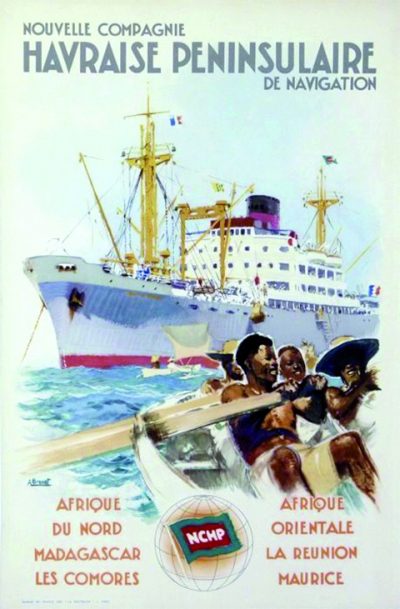
The Seychelles became a French colony in 1770 and take their name from the Vicomte Moreau de Sechelles, who was controller general of finance under Louis XV. The islands were ceded to Britain in 1814 and administered as part of Mauritius until 1903 when they became a Crown Colony. The island of Mahe is named after a French nobleman, and today there are ferry and freight services from its capital of Victoria to the islands of Praslin and La Digue, as well as to Durban by several shipping companies such as the Seychelles Shipping Line. The Comoros Archipelago lies between Madagascar and the east coast of Africa, with the island of Mayotte today administered separately by France from the other islands. The official language is French, and the Comoros achieved unilateral independence in July 1975. Mayotte rejected the new Government of the Comoros proposal that it should join under a federal system, and there is little support from the local population for that today.
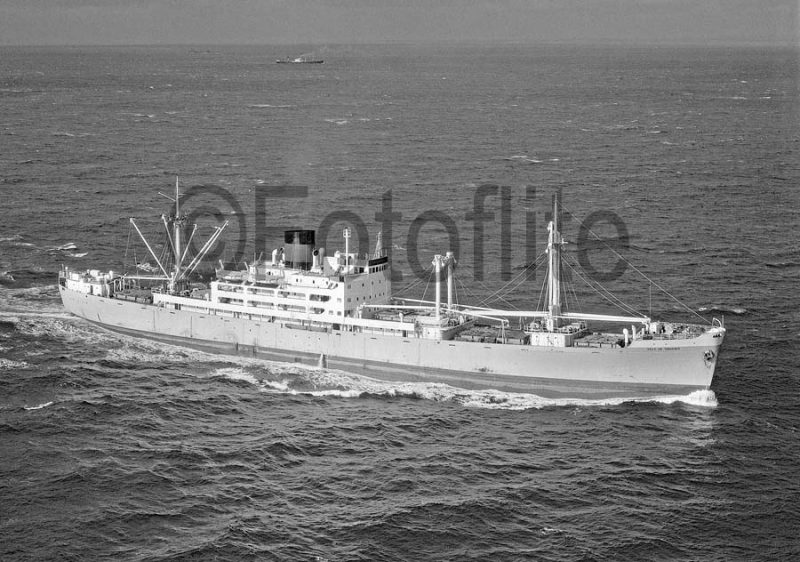
Mauritius (790 square miles) first received French settlers in 1715 and they named the island Ile de France, however the British captured the island in 1810 and restored its original name of Ile de Maurice or Mauritius. The official languages today are French and English, with the population mostly now of Indian and African origin, with the island having a very Indian and French flavour. The capital and port of Port Louis exports large amounts of sugar and its by-products, tea, tobacco, aloe fibre and local agricultural products, with rice as the main import.
Rodrigues Island lies 560 kilometres north east of Mauritius, named after its discoverer Diego Rodrigues of Portugal in 1528. France colonised the island in the name of Louis XV and sent 36 settlers in 1725. British rule was confirmed in May 1814 by the Treaty of Paris, and it was administered as a British dependency of Mauritius until 1972 when Mauritius became independent of Britain. The Chagos Archipelago to the north originally had French settlers and then came under the jurisdiction of Mauritius under the British. The Chagossian population were evicted by the British when they signed away the island in December 1966 on a fifty year lease to the U.S.A. as a military base. The local population were exiled to Mauritius, the Seychelles and Britain, and their fight to return to their own island in 2016 when the lease expires is ongoing. The coral atoll harbour of Diego Garcia was much used by the Allies as a naval and flying boat base during World War II for Sunderland and Catalina flying boats hunting Japanese submarines.
Compagnie Havraise Péninsulaire
A service was established to French possessions in the Indian Ocean in 1882 by the newly established Compagnie Havraise Péninsulaire, the articles of association being deposited before two notaries in Paris on 16th March 1882. The Head Office was at 38 Rue Bergere while the general management of maritime operations was based at Le Havre, the home port of the steamers. The capital of the company was ten million francs, and it took over three lines from Armement Eugene Grosos, dating from 1865. Eugene Grosos was one of the major shareholders of the new company, and he had pioneered lines from Le Havre to Algeria, to the Iberian peninsula, and to Port Vendres on the Spanish/ French border and Marseille. The Peninsular Line gave its name to the new shipping company of 1882, and had used steamers such as Ville d’Alger of 1,699 grt, Ville de Brest of 1,017 grt, Ville de Cadix of 892 grt, Ville de Lisbonne of 1,292 grt, Ville de Malaga of 1,072 grt, Ville de Marseille of 1,072 grt, Ville de Messine of 1,003 grt, Ville du Havre of 513 grt, as well as the small steamers Constantin of 528 grt and Emma of 778 grt.
These small steamers used sails as auxiliary propulsion and to steady them in fresh winds, and had a crew of between 22 and 28 men with compound steam engines of between 500 and 900 horse power. Eight new larger steamers of up to 2,350 grt were then delivered between 1882 and 1884 from shipbuilders on the Wear such as Laing, Blumer and Thompson, with a greater range and able to venture through the Suez Canal and down the Red Sea to Aden, the Seychelles, Reunion and Mauritius on a regular service. One of the octet served as a coastal feeder ship when she arrived on the east coast of Madagascar in 1884 as Ville de Riposto from the Wear shipyard of Robert Thompson, and served for fifteen years until she was wrecked near Farafangana on Madagascar on 29th January 1899. Ville de Malaga and Ville de Tarragona were two of the new larger octet in the Indian Ocean, and both suffered unfortunate fates, with Ville de Malaga sold to Hulin of Rouen in 1896 and she was wrecked a year later on 14th August 1897 on Alderney. Ville de Tarragona sailed from Le Havre in the evening of 13th November 1907 and was in collision a few hours later with the steamer Suzanne and Mary, being badly damaged and was demolished a few months later after being towed back to port. The other steamers of the octet were Ville de Metz (wrecked at Sarco Punto near Coquimbo in Chile on 28th August 1886), Ville de Strasbourg, Ville de Cadix (missing on a voyage from Algiers to Le Havre in 1893), Ville de Palerme (wrecked at Ushant in 1886), and Ville de Valence.
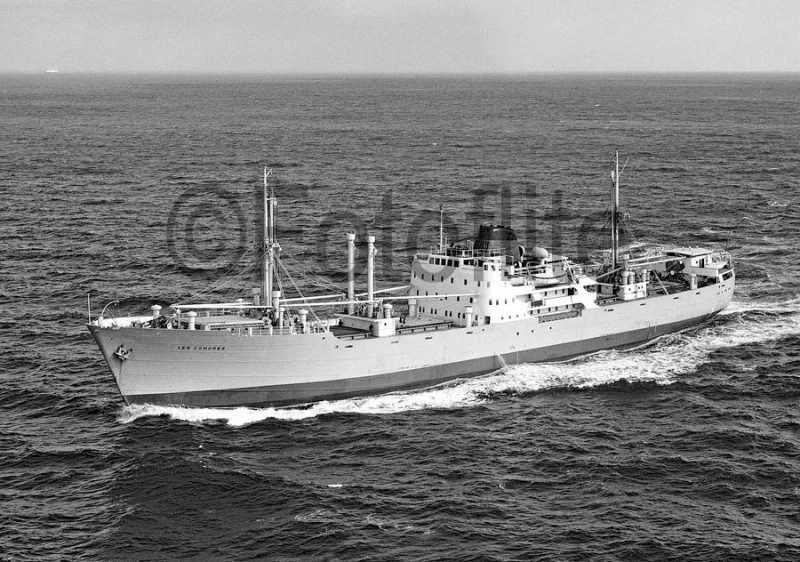
In 1885, the Havraise company services were becoming widely known in the Persian Gulf, the Indian Ocean and the Mascarene islands of Reunion, Rodriguez and Mauritius. Departures to the islands were every 45 days in 1885, monthly from 1891 and fortnightly from 1901. The ships of the Havraise company were then synonymous with the Mascarene islands for a century, and this continued after the merger with Delmas Vieljeux in 1986. Madagascar had become a French protectorate in 1885 and opened up new trade opportunities, with Ville de Metz of 3,265 grt launched by Laing at Sunderland on 23rd June 1887 with a speed of 14.5 knots from triple expansion steam engines and good accommodation for 22 First Class passengers and a dozen in Second Class. She was followed by a near sister in February 1888 as Ville de Belfort from the same yard.
A coastal cabotage service was provided for the harbours and inlets of Madagascar from July 1897 using Tafna of 1,617 grt and purchased in 1893. The new Governor General of Madagascar from 1896 to 1905 was the ebullient Joseph Galieni (1849-1916), who during this period exiled Queen Ranavalona III to Reunion and abolished the 350 year old monarchy of Madagascar. The directors of the Havraise Péninsulaire noted in a 1897 report that the line to Madagascar, Reunion and Mauritius was now considered to be the ‘backbone’ of the company services, loading sugar for the majority of the months of the year, and only occasionally being forced to load cargo on the Coromandel coast at Cochin in India and at Bombay. Cochin has a good harbour watched over by Fort Cochin with much French, Dutch and Portuguese influence of the early explorers.
The Havraise Péninsulaire pioneered other lines including to Peru, Ecuador and Chile in conjunction with Compagnie Maritime du Pacifique of Havre in 1889. However, the civil war in Chile in January 1891 lasted most of the year with ports blocked and business paralysed. The movement of cargo and passengers was much reduced as was the frequency of departures. The situation worsened in 1893/94 with depressed freight rates, increased competition from British and German lines, and natural disasters such as earthquakes, and led to services being completely suspended in 1895. Traffic was later resumed with some satisfactory results obtained until the service was abandoned at the start of the Great War in August 1914. A Caribbean Line was also begun and lasted for the same duration, and Havraise Péninsulaire ships made regular voyages to Cochin in India and occasionally to the Tonkin region of Vietnam, Port Arthur in Texas, and Odessa on the Black Sea to load grain and general cargoes.
The steamer Obock of 2,413 grt built in 1884 was purchased in November 1888 but was lost by collision in the English Channel in June 1894 with the steamer Willelma, her crew being fortunately saved. Madagascar of 2,910 grt was a product of the Swan and Hunter yard on the Tyne in 1890 but stranded at Algeciras in 1909, and after refloating was broken up at Stettin. Ville de Paris of 3,209 grt was completed in 1890 and sold in 1902 to Ellerman and Papayanni Line and renamed Alexandria. Ville du Havre of 3,281 grt was completed by the Laing yard at Sunderland in 1890 and sold back to her builders in 1903 and renamed Lonsdale to pay for new tonnage. Perou of 3,166 grt also came from the Laing yard in 1890 and was purchased in October 1895 and sold in 1902. Ile de la Reunion of 3,888 grt was completed in 1897 and after five years service was sold back to her builder, the Laing yard, and renamed Swaledale. Ville de Tamatave of 3,744 grt also came from the Laing yard in 1899, as did Diego Suarez of 3,883 grt during 1900. The fleet strength on 31st December 1900 was fourteen steamers of 57,600 dwt and was ranked fifth in size of French shipping companies.
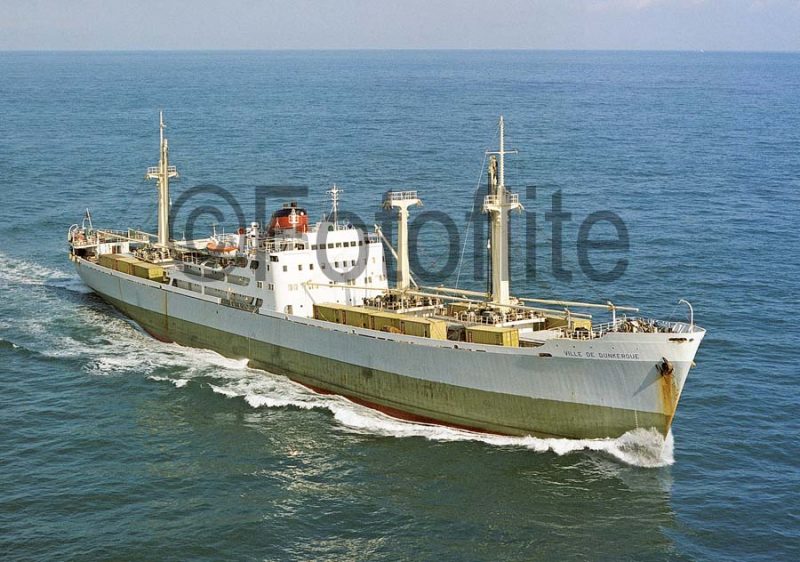
Havraise Péninsulaire In The 20th Century
The company now had worldwide shipping routes ranging from the eastern Mediterranean to the Indian Ocean, South America and the Caribbean. However, competition on the original Peninsula Line to Spain and Portugal became too severe and the service from Le Havre was abandoned in 1908. New tonnage after 1907 came from the Ateliers et Chantiers de France and the Forges et Chantiers yards at Le Havre, when seven steamers in the range of 6,500 to 7,000 dwt were ordered. The first steamer to be built by a French yard for the company was Ville de Paris of 6,650 dwt in 1903. The septet from French yards during the five year period from 1907 to 1912 was Ile de la Reunion, Eugene Grosos, Ville de Marseille, Ville de Bordeaux, the twin screw turbine powered Ville d’Oran, Ville d’Alger and Colbert. The steamer Conde of 9,120 dwt was a stretched version of this septet from the Forges et Chantiers yard in Le Havre in early 1915. Fleet strength at the start of World War I on 3rd August 1914 was fourteen steamers of 91,900 dwt. The company was to lose six steamers during the course of the war, with another lost soon after being sold and several others badly damaged. These were:-
Ville de Mostagenam, the former Highland Chief of Nelson Line built in 1890, was sold to French Line in April 1915 and lost soon afterwards on 9th September to a torpedo from U39 while on a voyage from Marseille to Oran with a cargo of empty wine casks and barrels.
Colbert was torpedoed and sunk on 30th April 1917 while on a voyage from Marseille to Salonika.
Ville de Havre valiantly defended herself during the afternoon of 1st June 1917 from the gunfire of U48 off Cape Finisterre, but was torpedoed and sunk during that night.
Bouvet was purchased in 1917 and was badly damaged in a collision off Bone harbour in the evening of 13th September 1917 with the steamer Orenoque of French Line. Bouvet sank and Orenoque suffered heavy bow damage but reached Port de Bouc safely, one or both of these steamers was unlit.
Ville de Bordeaux was torpedoed and sunk on 18th January 1918 by U63 off Cape Caccia in Sardinia.
Djibouti was torpedoed and sunk on 28th January 1918 by U34 off Cape Bengut in North Africa.
Ville de Verdun was on her maiden commercial voyage when she was torpedoed and sunk on 6th February 1918 by U34 off Guadamar in Spain while on a voyage from Dakar to Marseille, ten crew lost.
Ten shelterdeckers of up to 9,500 dwt were ordered from British yards during 1917/18, with one ship undelivered and one, Ville de Verdun, lost as a result of war action in 1918. Eight of the ships came from the Londonderry yard of the North of Ireland Shipbuilding Co. Ltd., managed by Swan, Hunter & Wigham Richardson Ltd. during 1920 to 1924. These were Ville de Verdun of 1917, Ville d’Arras of 1918, Ville du Havre of 1919, Ville de Rouen of 1919, Ville de Metz of 1920, Ville de Strasbourg of 1920, Ville de Verdun of 1921, and Ville d’Amiens, the completion of the latter delayed until 1924 when the yard was closed down. The tenth ship came from the Port Glasgow yard of William Hamilton & Co. Ltd. as Ville de Reims in 1918. Ville de Strasbourg, Ville d’Amiens and Ville de Verdun were chartered from new to Messageries Maritimes for a service from Northern Europe to New Caledonia and Australia, and then purchased in 1928 and given passenger accommodation for forty First Class passengers and fifty Second Class passengers for the Pacific feeder services.
The fleet was also increased in 1920 by four managed ships that had been requisitioned during the war, with Catinat of 7,057 grt being a war reparations vessel from Germany, and Ville de Djibouti (ex Verdun, Bayverdun) becoming Ville de Djibouti, Malgache (ex Cayo Romano, Baymano), and Bourbonnais (ex Saint Kentigern, Baytigern) becoming a managed ship until purchased in 1934. One of the most tragic events in the annals of the company occurred on 1st February 1920 when Ville d’Alger sailed from Port des Galets on Reunion but caught fire seventy miles north of the port. Ville du Havre found her burnt out wreck three days later but no sign of her crew, but on 9th February a lifeboat with twenty survivors had landed on the coast of Madagascar at Foulpointe as the only survivors.
Nouvelle Compagnie Havraise Péninsulaire (NCHP)
The Grosos family were still directors and shareholders of the company on 15th April 1920 when the company ceased to be directly controlled, with management entrusted instead for five years to the Transoceanic Navigation Company. Serious financial difficulties were being encountered in the boom and bust of the early post-war years, combined with a very large building programme in British yards with prices escalating by up to one half. The franc was also devalued against the pound by one half. The slump at this time was only handled by the company reorganising itself to stay in business and cancelling the last contract of ten placed with British yards.
The reorganisation helped the company regain its financial acumen when slightly better freight rates were encountered in 1924 to operate a larger fleet of seventeen vessels and the long term charters of four managed vessels. One of the new purchased vessels had been built by the Kawasaki Dockyard in 1916 as Argonne and was purchased in 1922 from American owners and renamed Calonne.

The steamer Havraise was badly damaged by a tidal wave in 1927 at Pointe des Galets on Reunion, with repairs taking nine months before she could re-enter service. Ville de Marseille was also caught in a particularly violent cyclone in March of that year, but made the harbour at Tamatave on Madagascar safely. Catinat was not so lucky in the same storm as she was wrecked at the mouth of the Ivolina river to the north of Tamatave.
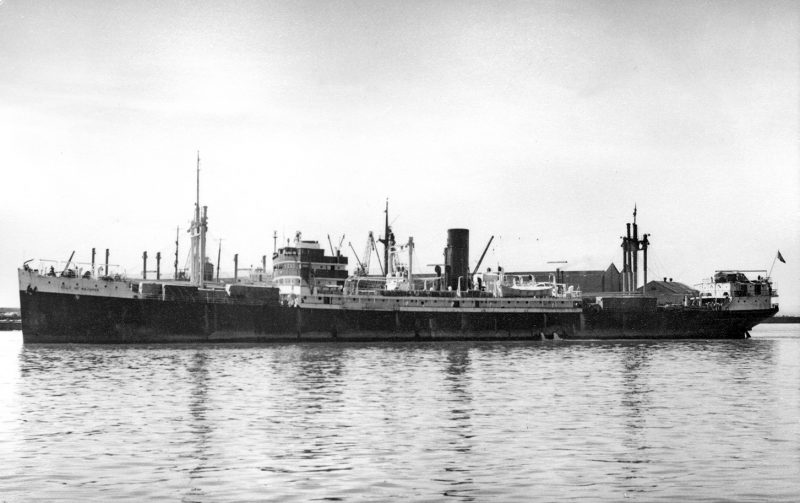
On 1st January 1928, the Havraise Péninsulaire amicably cancelled its management agreements with the Transoceanic Navigation Company and at the same time the Grosos family sold their shareholdings. This gave a new independent direction to the company to continue with the operation of their main shipping line to the Indian Ocean. Trinder & Anderson later in the year sold their Australind of 4,839 grt to the company to become Colbert, and she was traded for five years until sold to the Compagnie Baltique Ocean Mediterranean. Two vessels were lost at this time, Ville de Majunga wrecked near Mahanoro on Madagascar, and Ville de Djibouti also wrecked on Madagascar. Ville de Marseille had just been repaired after cyclone damage in 1927 when she was badly damaged by fire aft, and although repaired, she was broken up in 1935 after further lay ups during the Depression.
No new ships entered the fleet for seven years between 1924 and 1931, as trading conditions became bleak towards the end of 1929 after a Stock Exchange financial crash in New York. Trade became almost impossible with the NCHP particularly ill placed to cope with falling freight rates and rising expenses of all kinds producing big losses. On 1st June 1930, an agreement with the French trading and shipping companies of Worms et Compagnie and Schneider et Compagnie, and credit companies in Algeria and Tunisia, was made whereby the NCHP entrusted the management of its fleet to the ‘Corporation Operating Company Havraise Péninsulaire’. The entire share capital of the company was increased at a meeting on 2nd January 1934, and the company name was changed to the Nouvelle Compagnie Havraise Péninsulaire (NCHP), with Monsieur Hypolite Worms as the new President. He was the grandson of the founder of Worms et Compagnie of the same name, who had begun in business in 1848 by importing Tyne and Cardiff coal to Rouen, and exporting plaster of Paris, a fine, white plaster made of gypsum. The founder died in 1877, with his grandson having varied business interests in banking, shipowning and shipbuilding in the inter-war years.
The Depression had reached its lowest point at this time, but difficulties still remained, further exacerbated by the loss of Ville de Paris in 1935 when her bottom was ripped open by rocks while en route from Fort Dauphin to Farafangana in Madagascar. The fleet numbered fourteen vessels in 1935 with the two latest vessels, Ville de Tamatave and her sister Ville de Majunga of 7,065 dwt, having been completed in 1931 by the Le Trait yard owned by Worms et Compagnie and powered by triple expansion steam engines manufactured in the yard to give a service speed of thirteen knots. The NCHP had recovered from all of its inter-war financial difficulties by 1939, and was operating a fleet of ten owned or managed vessels of 78,500 dwt on the outbreak of war on 3rd September 1939. These were Bourbonnais, Conde, Malgache, Ville d’Oran, Ville de Majunga, Ville de Metz, Ville de Reims, Ville de Rouen, Ville de Tamatave and Ville du Havre. NCHP was managing its first motor vessel, Malgache of 8,558 dwt, launched in July 1939 at the yard of Ateliers et Chantiers de la Seine Maritime for the French Government. She had a draft of 26.8 feet and accommodation for a dozen passengers with a service speed of eighteen knots from a powerful Sulzer diesel engine. The fleet sailed from Le Havre, Pauillac and Marseille to the Suez Canal, Port Sudan, Djibouti, Diego Suarez, Tamatave, Vatomandry, Mananjary, Farafanga, Fort Dauphin, Port Louis, Saint Denis and Pointe des Galets.
One half of the fleet of ten ships were lost to enemy action during World War II, with in addition, Ville de Reims taken over by Germany at Hamburg in June 1940 and renamed Harvestehude. She was badly damaged by a torpedo between Bergen and Floro in November 1942 and spent the rest of war in port, reverting to her French name and French crew at the end of the war. The company ships and all of the remainder of the French Merchant Marine was requisitioned on 15th September 1940 under the management of the French Maritime Transport Directorate. The five ships lost were:-
Ville du Havre was shelled and sunk near Casablanca on 8th November 1942 when Allied troops landed in North Africa.
Ville de Rouen was torpedoed and sunk on 28th December 1942 in the North Atlantic while on a voyage from Glasgow to Ascension and Beira with general cargo, having been seized by the British in 1941, all her crew was saved.
Ville de Tamatave was arrested by the British authorities in January 1941 off St. Helena, and was lost with all hands in the North Atlantic off New York on 24th January 1943.
Ville de Metz was requisitioned by the German authorities in August 1940 and was lost in February 1943 under the name of Othmarschen.
Conde was seized by the German authorities in 1943, and bombed in Villefranche harbour in February 1944, and again bombed, burned and sunk in the port of Nice later in 1944. She was considered irreparable at the end of the war and was broken up in 1947.
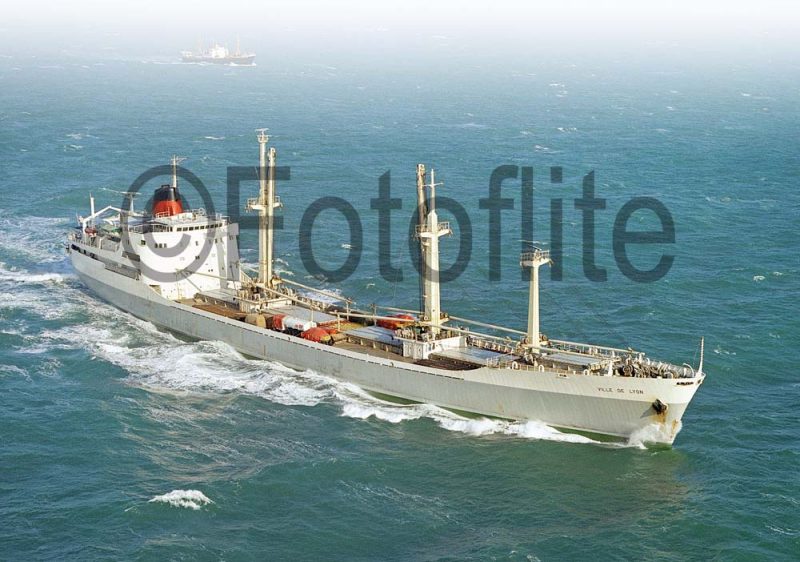
The company was left with only five vessels, three of them very old, at the end of the war in Madagascar dating from 1911, Bourbonnais of 1914, Ville de Reims of 1918, Ville de Majunga of 1931, and the newer motorship Malgache of 1939 that had been captured at Bordeaux by German forces and was found in good condition in the port of Hamburg at the end of the war.
NCHP In Post-War Years
NCHP had to rebuild its fleet, its agencies in Madagascar, Reunion and Diego Suarez, and recruit new crews at the end of the war for four bareboat chartered war standard ships in Empire Moulmein, built in 1944 by the Readhead yard at South Shields and renamed Ville de Diego Suarez, and three ‘Liberty’ types renamed Ville du Havre, Colmar and Plouharnel. The U.S. Marshall Aid plan gave extra assistance to the rebuilding of infrastructure in the bomb damaged port of Le Havre and the office of NCHP and its head office in Paris. Three coastal vessels were transferred from the surviving fleet of Worms et Compagnie in Ville de Manakara (ex Chateau Pavie) of 2,047 grt, Ile Sainte Marie of 1,106 grt, and Ville de Tulear (ex Chateau Latour) of 1,912 grt for trading around the ports of Madagascar. The agency at Tamatave in Madagascar became in 1951 the Auxiliaire Compagnie Maritime Madagascar (Auximad).
The capital of NCHP was increased in 1948 from 22 million francs to 109 million francs to pay the instalments on two new vessels of 8,565 dwt on order at Ateliers et Chantiers de la Seine Maritime. They were delivered in 1949/50 as Ville de Tamatave and Ville de Tananarive with comfortable accommodation for thirty passengers, and were based on the design of Malgache of 1939. They were followed by three vessels with similar sized hulls but different superstructures from the Odense yard in Denmark and the Le Trait yard as Ile de la Reunion, Ile de Maurice and Nossi Be of 9,800 dwt. A smaller vessel of 4,031 grt for the coastal trades in the Comoros Islands was purchased on the stocks at the Kieler Howaldtswerke yard and launched on 30th August 1952 as Les Comores. A further coastal vessel for the Madagascar trades was purchased in May 1954 after being completed in 1953 at the Hamburg yard of H.C. Stulcken Sohn as Commerz, renamed as Ville de Fort Dauphin of 3,215 dwt.
A new line to the Persian Gulf was begun in 1955, as well as the second wave of fleet modernisation. This comprised five fast cargo-liners of between 9,200 dwt and 11,100 dwt in Ville de Djibouti (1955), Ville de Dunkerque (1957), Ville de Rouen (1957), Ville de Majunga (1958) and Ville de Nantes (1958). They had streamlined and raked bridge fronts to the superstructure, carried six passengers in some comfort, with streamlined funnels, five holds and hatches, three masts of square cross section, deep wine tanks, a dozen small derricks, and two heavy lift derricks on the fore and mizzen masts. A good service speed of sixteen to eighteen knots provided a monthly service to the Indian Ocean with many ports visited, and much unloading and loading of cargo in open anchorages. A third phase of cargo-liner newbuilding took place between 1962 and 1966 with five sister ships of 12,300 dwt from the Le Trait yard including Ville de Bordeaux, Ville de Brest, Ville de Lyon and Ville du Havre. They were engines aft vessels with a good service speed of nineteen knots from B & W oil engines.
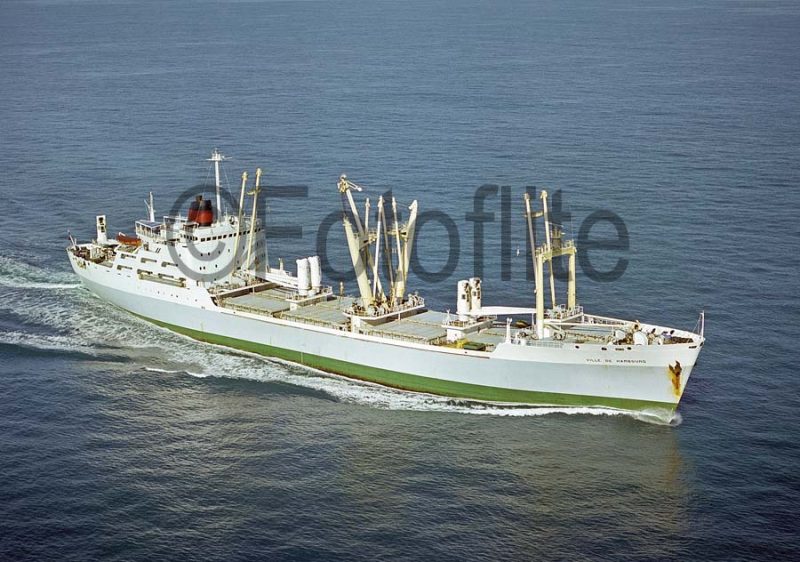
A subsidiary was created in 1959 in Iran, with a small coaster Kamal (ex Atlanta) purchased for the cabotage trade from the Iranian side of the Persian Gulf to the Arabian side. The long term chartered cargo-liner Eugene de Pierre Caplane was purchased in 1959 and renamed Ville de Manakara of 9,500 dwt.
Madagascar started the struggle for independence from October 1958, which together with Arab-Israeli Wars and blockages of the Suez Canal, forced the NCHP to set-up subsidiaries in Madagascar to protect their interests. The Compagnie Malagasy de Navigation (CMN) was set-up in June 1960, with the NCHP holding the majority of the capital, while the Auxiliaire Compagnie Maritime Madagascar (Auximad) operated in all of the Malagasy ports for freight forwarding and cargo operations. The Societe Malagache de Transport Maritimes (SMTM) was established in June 1962 for banana and fruit transportation from the growing plantations of the Frutiere Co-operative Madagascar in the Tamatave region. Two reefers of nine thousand cubic metre capacity, Ivolino and Ivondro of 6,625 dwt with a twenty knot service speed, were completed between 1966 and 1969 for the transport of bananas to France. Two smaller vessels of 5,000 dwt were transferred from the Red Sea services of Worms et Compagnie to the SMTM and the Societe Mauricienne de Navigation (SMN), both with 68% of NCHP capital, and renamed Diego Suarez and Ville de Port Louis. An engines aft vessel of 7,500 dwt was transferred to SMN in 1973 and renamed Ville de Mahebourg, having been purchased in 1970 as Saint Francois and renamed Ville de Djibouti. She had a service speed of fifteen knots and a good array of derricks on three masts for the Indian Ocean feeder services.
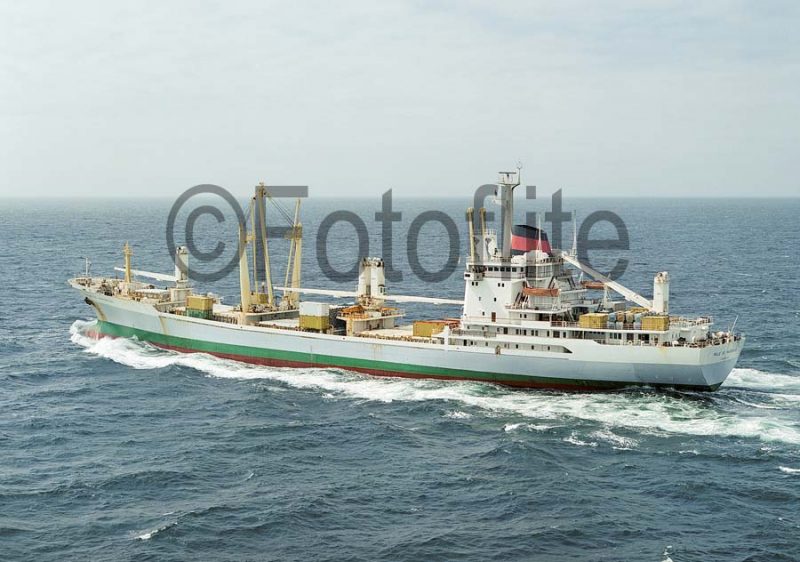
In December 1968, another reorganisation by Worms et Compagnie created the Societe Nantaise des Chargeurs de l’Ouest to include bulk carrier, specialised vessels and tankers, with the cargo-liners of the NCHP then managed by the Navale et Commerciale Havraise Péninsulaire (NCHP). A fleet of fifteen cargo-liners with ‘Ville’ names was operated by the NCHP in 1975, including six new ships of between 13,880 dwt and 16,265 dwt, completed during 1970/75 as Ville de Hambourg, Ville de Rotterdam, Ville de Genes, Ville de Strasbourg, Ville de Valence and Ville de Nantes, all from the La Ciotat yard. Two standard ‘Ozean’ type sisters had been completed at the Warnowwerft yard during 1968/71 at Rostock as Ville de Reims and Ville de Sete. They had good deck container capacity as well as a good complement of 80 tonne heavy lift Stulcken derricks and pedestal cranes.
In March 1973, the Havraise Australia Red Sea Service (HARSS) was established for the transport of Australian sheep, cattle and grain to Middle East ports, especially to Jeddah, using the chartered Astree ex Ile de la Reunion and Pegase ex Nossi Be. A joint service with CMB of Belgium was also set up in 1975 from the Eastern Seaboard of the U.S.A. and the Gulf of Mexico to the Persian Gulf as MEGA Line (Middle East Gulf Atlantic Line). Five engines aft multi-purpose cargo-liners of 23,650 dwt were completed in 1977/78.
Ville d’Anvers and Ville de Bordeaux were built in Norway as general cargo carriers and were lengthened during 1980/82 and converted into container ships. Ville de Brest, Ville de Reims and Ville de Rouen were built at Seville by Astilleros Espanoles, and were distinguished by 135 tonne Stulcken derricks and big rectangular funnels. Two twin funnelled ro-ros were completed in 1978 at Dunkirk as Ville de Dunkerque and Ville du Havre of 22,000 grt, and two further sisters were also completed in 1979/80 for charter to Costa Line as Ro-ro Genova and Ro-ro Manhattan.
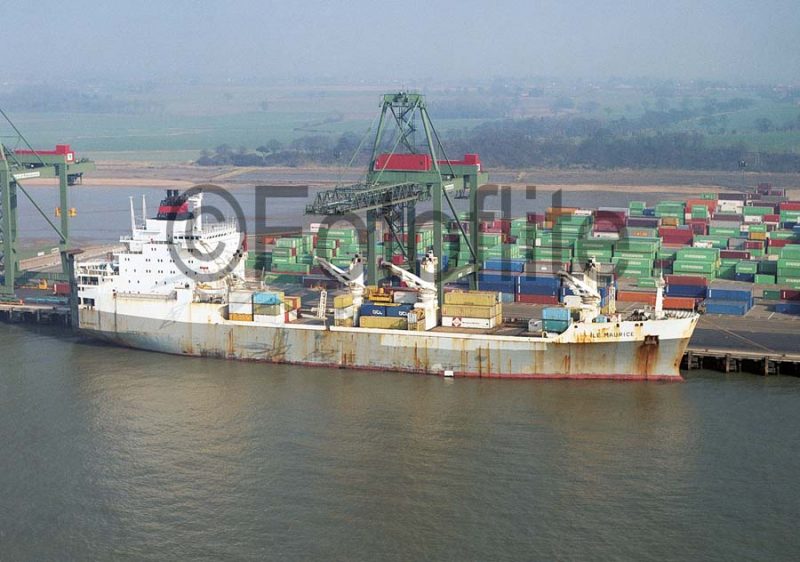
The NCHP fleet size on 1st September 1982 was thirteen vessels of 250,000 dwt in Ville d’Anvers, Ville de Bordeaux, Ville de Brest, Ville de Dunkerque, Ville de Genoa, Ville du Havre, Ville de Marseille, Ville de Nantes, Ville de Reims, Ville de Rouen, Ville de Strasbourg, Ville de Valence and Ile de la Reunion. Two of the ‘Painter’ class of six ro-ros were purchased in 1983 from CGM, the 1977 fusion between Messageries Maritimes and Compagnie Generale Transatlantique (CGT). Cezanne was renamed Ile Maurice and Degas was renamed Ile de la Reunion, with CGM having used all of its several classes of post-war cargo-liners in the Indian Ocean. CGM and NCHP then collaborated on Europe to Indian Ocean and South East Asia services. Ville de Reims was renamed Artois and Ville de Rouen was renamed Armagnac, with Ville de Brest purchased by CGM and renamed Anjou for this service.
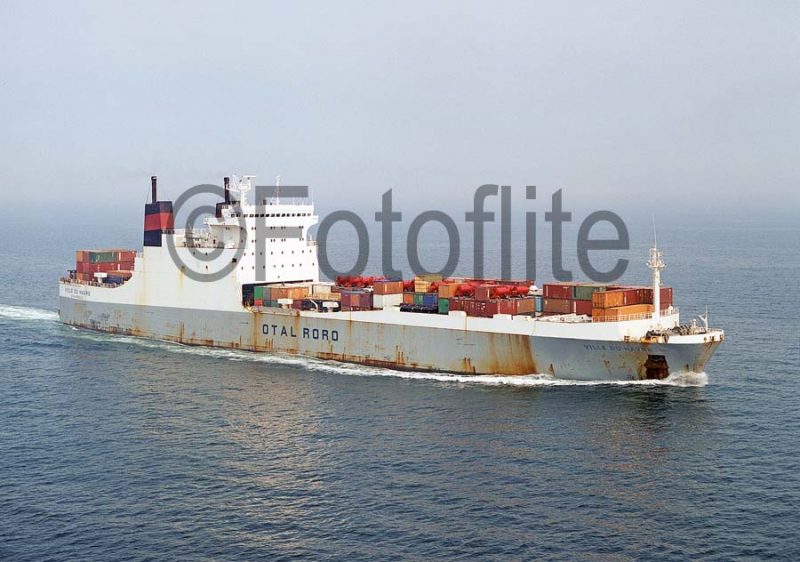
In June 1986, Worms et Compagnie and Delmas-Vieljeux SNCDV (Societe Navale Chargeurs Delmas-Vieljeux) of France decided to merge and concentrate their combined fleets on the Indian Ocean, Red Sea, Persian Gulf and West African services. SNCDV purchased a two thirds share in NCHP in order to better optimise the resources allocated to the two companies. The ‘Capricorn’ service to the Indian Ocean in 1987 received two SNCDV vessels of 26,300 dwt in Renee Delmas, renamed Ville de Rouen, and Suzanne Delmas, renamed Ville de Marseille. This marked the end of the very long era of Indian Ocean and Persian Gulf trading of Havraise Péninsulaire ships with black funnels with a central red band.
Postscript
Delmas-Vieljeux was thus the last French shipping company to operate conventional cargo vessels to the Indian Ocean, and had been founded in 1867 at La Rochelle by Emile Delmas for a French service to the Ile de Re, followed by services to the Mediterranean countries of Tunisia, Algeria and Morocco as well as to West Africa. Leonce Vieljeux was managing Delmas-Vieljeux at the end of the 19th century together with the Delmas brothers, but both families sold out a century later in 1991, and the company acquired the remaining liner activities of Chargeurs Reunis in 1996. The company was later taken over in August 2005 by CMA CGM, the third largest container line in the world. French container ships recently in service to the Indian Ocean and West Africa have been in the range of up to 35,000 dwt and 2,200 TEU capacity.

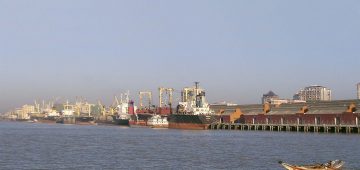



Comments
Sorry, comments are closed for this item